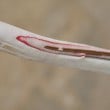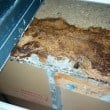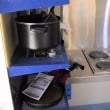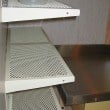B6.3 Insects: ants and cockroaches
Ants and cockroaches can spoil food, contaminate kitchen surfaces and may cause electrical faults. Cockroaches and their excreta have also been linked to asthma. Both ants and cockroaches are attracted to food scraps in the kitchen area.
Different species of ants may also be attracted to water, silicone, and electrical fittings and appliances that generate heat such as refrigerator motors, stoves and hot water systems. Cockroaches prefer to have as much body surface in contact with another surface as possible (they are ‘thigmotactic’). They also prefer to live in dark and damp environments and will seek out nooks and crannies for breeding.
There are still ant and cockroach populations in houses across Australia. Data show that 26% of houses had ants and/or cockroaches present at the time of survey. This is a significant reduction of 14% since 2013. However reports by residents of ants and / or cockroaches being present at sometimes during the year increased by 5% to 48%.
Data show 69% of houses had a functional splashback behind the kitchen sink to prevent moisture building up under the kitchen sink and in the cupboards. This represents a gradual improvement since 2006 and 2013. A functional splashback reduces moisture behind and below cupboards. A leaking splashback or failed sink drainage promotes a moist under cupboard environment is the ideal breeding habitat for cockroaches and ants.
Design and Specification
Ensure
- B6.3 .1.
particle board is not used, particularly in kitchens, because ants and cockroaches can eat the adhesives and tend to nest and breed in the material
- B6.3 .2.
the wall to floor junctions are sealed with a solid material
- B6.3 .3.
pantries have light, are screened and are ventilated to reduce humidity to reduce the incidence of cockroach infestation
- B6.3 .4.
the holes in cupboards and walls through which electrical conduits and pipes pass are sealed with a solid material, and not sealed with silicone which is subject to attack by ants
- B6.3 .5.
there is storage in kitchen, bathroom and laundry area to prevent food, wet clothes and towels being left on the floor, which might attract cockroaches and ants
- B6.3 .6.
electrical appliances are sealed with a solid or fine mesh material to eliminate gaps
- B6.3 .7.
joinery is detailed to eliminate gaps and spaces against walls and floors.
Consider
- using mesh shelves to deter cockroaches
- keeping the area under sinks and around stoves open, lit and dry, to reduce cockroach infestation
- keeping cupboards under the bench at least 300mm above the floor to allow light penetration and easy access for cleaning
- using benches with integrated splashbacks
- selecting electrical fittings that are less easily infested by ants and cockroaches.
Real world examples of Solutions
- B6.3 .1.
Quality control
- joinery, bench top and wall junctions are sealed to prevent water

- COMPLETED DESIGN & SPECIFICATION
DURING CONSTRUCTION
AT HANDOVER
FINAL COMPLETION
- COMPLETED DESIGN & SPECIFICATION
- floor to wall junctions are sealed to prevent water

- COMPLETED DESIGN & SPECIFICATION
DURING CONSTRUCTION
AT HANDOVER
FINAL COMPLETION
- COMPLETED DESIGN & SPECIFICATION
- openings in cupboards and walls for electrical conduits and pipes are sealed to prevent insects and vermin entry

- DURING CONSTRUCTION
AT HANDOVER
FINAL COMPLETION
- DURING CONSTRUCTION
- the kitchen pantry is ventilated.

- COMPLETED DESIGN & SPECIFICATION
DURING CONSTRUCTION
AT HANDOVER
FINAL COMPLETION
- COMPLETED DESIGN & SPECIFICATION
- joinery, bench top and wall junctions are sealed to prevent water
Maintenance
As part of cyclical maintenance:
- establish a pest reduction program carried out by a licensed contractor

- Pest Controller, Housing Management
- 6 Months
- check for, and destroy, ant mounds and cockroach nests

- Local Maintenance Team, Pest Controller, Housing Management
- 6 Months
- check that gaps, cracks and junctions are sealed

- Local Maintenance Team
- 12 Months
- cut back tree branches or plants that are near to, or touching, the house.

- Local Maintenance Team
- 12 Months
If sprays are used against cockroaches as part of a pest management program, ensure the spray is applied twice in one month: the first time to kill the live cockroaches and the second time to kill the recently hatched cockroaches. There are other alternatives, such as gels or foams that may be used as a single application that will act over time to kill live and newly hatched cockroaches. Consult with a licensed pest management contractor about the best system for the local conditions.
- establish a pest reduction program carried out by a licensed contractor




